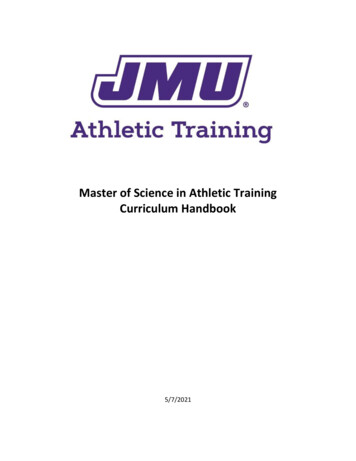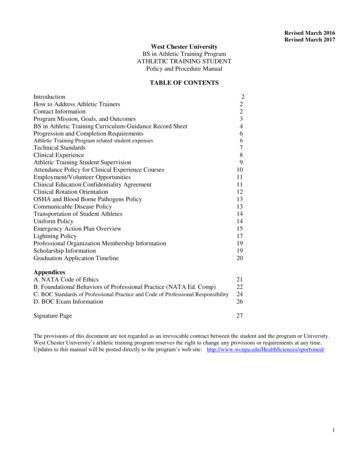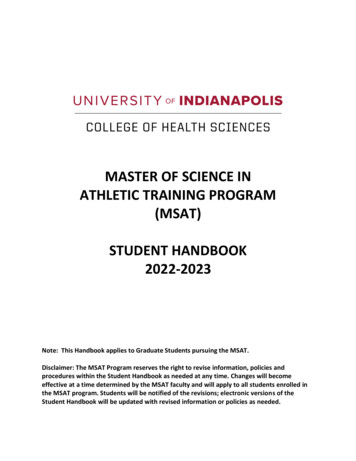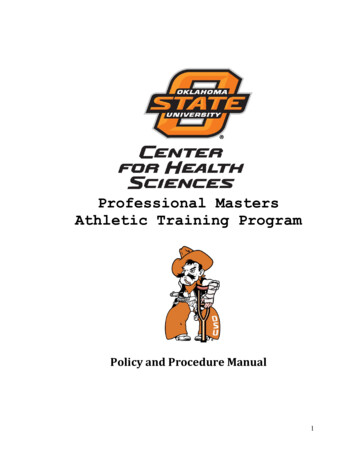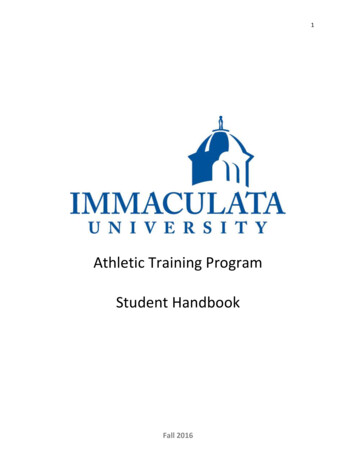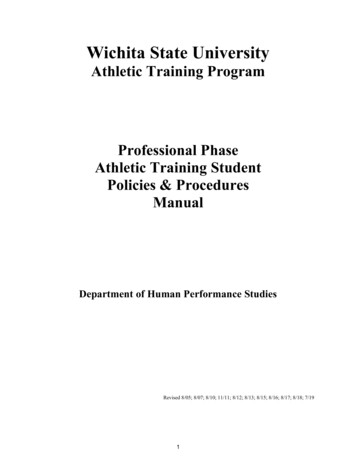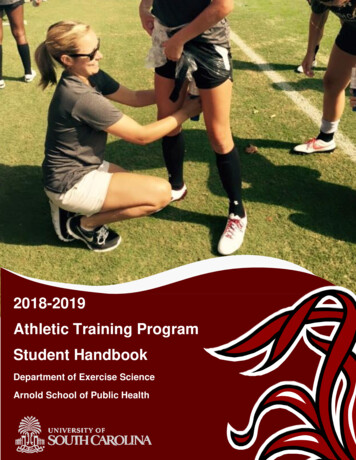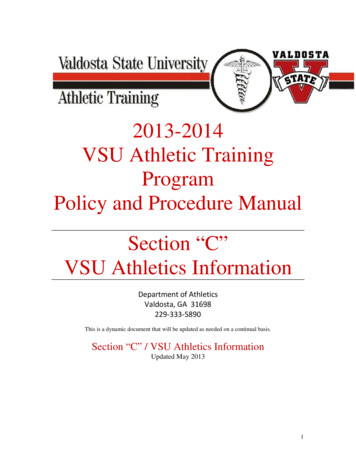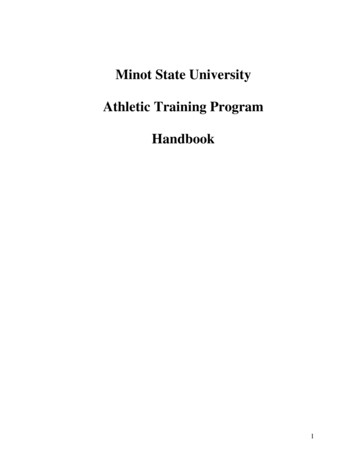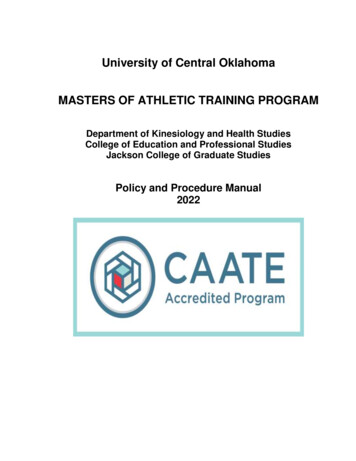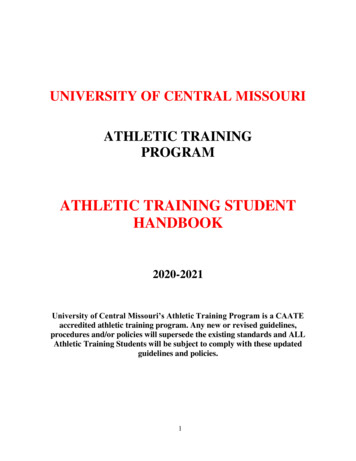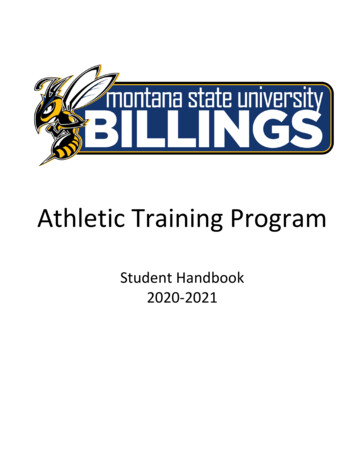
Transcription
Athletic Training ProgramStudent Handbook2020-2021
Montana State University BillingsAthletic Training ProgramTable of Contents . 1Welcome . 5I. INTRODUCTIONAthletic Training Profession . 6Standards of Ethical Conduct . 6NATA Code of Ethics . 7Regulation of Athletic Training . 8Essential Functions of an Athletic Trainer . 9II. ACADEMIC PROGRAMProgram Mission, Vision and Core Values . 11Learning Outcomes . 11Personnel and Responsibilities. 11III. ADMISSION and PROGRAM REQUIREMENTSPrerequisite Courses . 14Application Process and Admission Criteria . 14Technical Standards . 15Criminal Background Checks . 15Athletic Training Program Requirements . 18Application, Admission and Matriculation Requirements . 18Program and Retention Requirements . 18Graduation Requirements . 19Plan of Study . 19Cost of Attendance . 20Program Fees and Required Costs . 20Additional Student Expenses . 20IV. ATHLETIC TRAINING CURRICULUM at MSUBILLINGSAccreditation . 21Curricular Design . 21Interprofessional Education . 21Research Project/Thesis . 21Clinical Education /Field Experience Requirements . 22Clinical Rotation Plan . 22Clinical Education Experience Policy and Guidelines. 22Clinical Education Supervision . 22Clinical Education Experience Rotations . 23Hours . 23Clinical Site Orientation. 242
Montana State University BillingsAthletic Training ProgramName Badges . 24Student Travel . 24Fair Practices . 24Social Media and Electronic Communication . 25Cell Phone Use . 25Clinical Education Affiliated Site Information . 26V. STUDENT POLICIES AND PROCEDURESTransfer Students . 27Withdrawal and Refunds . 27Athletic Training Program and Academic Standards . 27Disciplinary Actions, Grievances and Appeals . 27Academic Dishonesty. 28Warning Policy and Process. 28Probation Policy and Process . 28Dismissal Policy and Process . 29Grievance Policy . 29Appeals Policy . 30Attendance . 30Dress Code and Personal Appearance . 30Confidentiality . 31VI. SAFETYCalibration and Maintenance of Therapeutic Equipment . 32Electrical Safety . 32Radiation Exposure . 32Hand Washing . 32Training and Hazardous Materials Management . 33OSHA, BBP, Infection Control. 33Bloodborne Pathogen Exposure/OSHA Form . 39Immunodeficiencies and Other Communicable Disease . 40Immunizations . 44Health and Safety . 44Accidents . 44Emergency Action Plans . 44Emergency Cardiac Training . 44VII. GRADES, ASSESSMENT and EVALUATIONGrade Policy . 45Student Evaluations . 45Athletes Student Self Evaluations . 45Program Journaling . 453
Montana State University BillingsAthletic Training ProgramClinical Preceptor and Clinical Site Evaluation . 45Faculty/Lab Instructor Evaluations . 45Master Program Assessment Plan . 46VIII. STUDENT SUPPORT and RESOURCESReference Material . 49Athletic Training Lab Equipment . 49Computer Equipment . 49Lab Use . 49MSU Billings Campus Resources . 49Counseling and Guidance Services . 49Student Clubs . 49Health Insurance. 49Liability Insurance . 50Student Athletes, Graduate Assistantships, Outside Work Commitments . 50Non-Discrimination Policies . 50Sexual Harassment Policies . 50Financial Aid, Awards and Scholarships . 51IX. STUDENT RECORDSStudent Records . 524
Montana State University BillingsAthletic Training ProgramDear Athletic Training StudentWelcome to the Montana State University Billings (MSUB) Master of Science in Athletic TrainingProgram! This handbook has been developed in order to help you in becoming a successful AthleticTraining Student. The handbook provides an overview of the professional athletic training program. definesthe policies and procedures of our program, and gives you a brief outline of what will occur during the nexttwo years.In March 2006, MSU Billings ATP was granted an initial five year full accreditation by theCommission on Accreditation of Athletic Training Education (CAATE) and in the August 2011 the AthleticTraining Program was reaccredited through 2020-2021. Current accreditation status does not guarantee theprogram will receive continuing accreditation status through yearly reports so we must all continue the workto maintain accreditation. Documents, forms and evaluative processes should contribute to continuousimprovement in the quality of the Athletic Training program.We believe the professional athletic training program at MSUB is of high quality and recognition.During the first year of the program, students will take majority of their classes on campus in face to faceformat and most of the courses during the second year are taught online by MSUB ATP faculty. During thefirst year, all of the clinical education experiences occur in the Billings area, however student may have theoption of apply for an off-site clinical rotation during their second fall semester. All students are required toparticipate in two immersive clinical education rotations. The first one is between summer and fall semestersof the first year. The second immersive clinical experience is a semester long rotation during the second fallsemester.In order to accomplish our goal of quality education and preparation for highly competentprofessional practice, faculty, staff, and Athletic Training students must all work together. This handbookallows you to become familiar with the roles and responsibilities that you have as an Athletic Trainingstudent as well as increase your awareness of proper policies and procedures for the program.Following orientation and review of this handbook, please read and sign the “Health, Safety andPolicy and Procedure Commitment Form”. Please return a copy of this signed form so it may be place intoyour record folder. This will indicate that you have a copy of the handbook and have reviewed all aspects ofthe education program.Once again welcome to the MSUB Athletic Training Program. We look forward to working with youas you work towards becoming a competent certified athletic trainer.Sincerely,Suzette Nynas, Ed.D., LAT, ATCProgram DirectorMontana State University Billings1500 University Dr., PE 119Billings, MT 59101Office: 406-657-2351snynas@msubillings.eduTori Atencio, MHA, LAT, ATCClinical Education CoordinatorMontana State University Billings1500 University Dr., PE 111Billings, MT 59101Office: 406-896-5939tori.atencio@msubillings.eduPlease beware that the policies and procedures within the ATP student handbook are subject to change due to changes includingbut not exclusive to CAATE standards, university, college, department and program curriculum and administrative policies andprocedures.Last update: Updated May 20205
Montana State University BillingsAthletic Training ProgramI. INTRODUCTION TO ATHLETIC TRAINING AND ATHLETIC TRAINING EDUCATIONThis MSUB ATP Athletic Training Student Handbook:This handbook includes the information, policies and procedures, and documentation and forms which willhelp you have a successful tenure in the Athletic Training program. Please read the handbook carefully andrefer back to it throughout the Athletic Training Program (ATP).Athletic Training ProfessionAthletic Training “encompasses the prevention, examination, diagnosis, treatment and rehabilitation ofemergent, acute or chronic injuries and medical conditions. Athletic training is recognized by the AmericanMedical Association (AMA), Health Resources Services Administration (HRSA) and the Department ofHealth and Human Services (HHS) as an allied health care profession” The Commission on Accreditation of Athletic Training Education oversees the accreditation of professionalathletic training programs. Currently the 2020 Standards guide athletic training education and include 6 corecompetencies. -Standards-Final-7-15-2019.pdf)Patient Centered CareInterprofessional Practice and Interprofessional EducationEvidence-Based PracticeQuality ImprovementHealth Care InformaticsProfessionalismThe Practice Analysis, for Athletic Training, 7thth edition defines the work of an athletic trainer and has beencompleted by the Board of Certification (BOC). The Practice Analysis includes the 5 practice domains for acertified Athletic Trainer. These include:Injury and Illness Prevention and Wellness PromotionExamination, Assessment and DiagnosisImmediate and Emergency CareTherapeutic InterventionsHealthcare Administration and Professional Responsibility(Henderson, J. The 2015 Athletic Trainer Practice Analysis Study. Omaha, NE: Board of document ine20170612.pdf?1497279231Standards of Ethical ConductStudents are expected to be familiar with university and athletic training program policies regarding studentconduct.Please see the university student handbook regarding student policies and udentHandbook.pdfStudents in the Athletic Training Program at Montana State University Billings are also expected to adhereto the MSUB ATP Professionalism Contract as well as the NATA Code of Ethics,http://www.nata.org/codeofethics/code of ethics.pdf.6
Montana State University BillingsAthletic Training ProgramNATA Code of Ethics (September 2005, revised 2018)(retrieved from http://www.nata.org/codeofethics/code of ethics.pdf)PreambleThe National Athletic Trainers’ Association Code of Ethics states the principles of ethical behavior thatshould be followed in the practice of athletic training. It is intended to establish and maintain high standardsand professionalism for the athletic training profession. The principles do not cover every situationencountered by the practicing athletic trainer, but are representative of the spirit with which athletic trainersshould make decisions. The principles are written generally; the circumstances of a situation will determinethe interpretation and application of a given principle and of the Code as a whole. When a conflict existsbetween the Code and the law, the law prevails.1. Members Shall Practice with Compassion, Respecting the Rights, Well-being, and Dignity of Others1.1 Members shall render quality patient care regardless of the patient’s race, religion, age, sex, ethnic ornational origin, disability, health status, socioeconomic status, sexual orientation, or gender identity.1.2. Member’s duty to the patient is the first concern, and therefore members are obligated to place the wellbeing and long-term well-being of their patient above other groups and their own self-interest, to providecompetent care in all decisions, and advocate for the best medical interest and safety of their patient at alltimes as delineated by professional statements and best practices.1.3. Members shall preserve the confidentiality of privileged information and shall not release or otherwisepublish in any form, including social media, such information to a third party not involved in the patient’scare without a release unless required by law.2. Members Shall Comply With the Laws and Regulations Governing the Practice of AthleticTraining, National Athletic Trainers’ Association (NATA) Membership Standards, and the NATACode of Ethics2.1. Members shall comply with applicable local, state, federal laws, and any state athletic training practiceacts.2.2. Members shall understand and uphold all NATA Standards and the Code of Ethics.2.3. Members shall refrain from, and report illegal or unethical practices related to athletic training.2.4. Members shall cooperate in ethics investigations by the NATA, state professional licensing/regulatoryboards, or other professional agencies governing the athletic training profession. Failure to fully cooperate inan ethics investigation is an ethical violation.2.5. Members must not file, or encourage others to file, a frivolous ethics complaint with any organization orentity governing the athletic training profession such that the complaint is unfounded or willfully ignore factsthat would disprove the allegation(s) in the complaint.2.6. Members shall refrain from substance and alcohol abuse. For any member involved in an ethicsproceeding with NATA and who, as part of that proceeding is seeking rehabilitation for substance or alcoholdependency, documentation of the completion of rehabilitation must be provided to the NATA Committeeon Professional Ethics as a requisite to complete a NATA membership reinstatement or suspension process.3. Members Shall Maintain and Promote High Standards in Their Provision of Services3.1. Members shall not misrepresent, either directly or indirectly, their skills, training, professionalcredentials, identity, or services.3.2. Members shall provide only those services for which they are qualified through education or experienceand which are allowed by the applicable state athletic training practice acts and other applicable regulationsfor athletic trainers.7
Montana State University BillingsAthletic Training Program3.3. Members shall provide services, make referrals, and seek compensation only for those services that arenecessary and are in the best interest of the patient as delineated by professional statements and bestpractices.3.4. Members shall recognize the need for continuing education and participate in educational activities thatenhance their skills and knowledge and shall complete such educational requirements necessary to continueto qualify as athletic trainers under the applicable state athletic training practice acts.3.5. Members shall educate those whom they supervise in the practice of athletic training about the Code ofEthics and stress the importance of adherence.3.6. Members who are researchers or educators must maintain and promote ethical conduct in research andeducational activities.4. Members Shall Not Engage in Conduct That Could Be Construed as a Conflict of Interest, ReflectsNegatively on the Athletic Training Profession, or Jeopardizes a Patient’s Health and Well-Being.4.1. Members should conduct themselves personally and professionally in a manner that does notcompromise their professional responsibilities or the practice of athletic training.4.2. All NATA members, whether current or past, shall not use the NATA logo or AT logo in theendorsement of products or services, or exploit their affiliation with the NATA in a manner that reflectsbadly upon the profession.4.3. Members shall not place financial gain above the patient’s well-being and shall not participate in anyarrangement that exploits the patient.4.4. Members shall not, through direct or indirect means, use information obtained in the course of thepractice of athletic training to try and influence the score or outcome of an athletic event, or attempt toinduce financial gain through gambling.4.5. Members shall not provide or publish false or misleading information, photography, or any othercommunications in any media format, including on any social media platform, related to athletic training thatnegatively reflects the profession, other members of the NATA, NATA officers, and the NATA office.In addition to abiding by the NATA Code of Ethics, students are also expected to adhere to the standards ofthe Health and Human Performance Department, the College of Health Professions and Sciences and MSUBillings as well as abiding to the BOC standards: http://www.bocatc.org.ATHLETIC TRAINING STUDENTS WILL MAINTAIN PROFESSIONALISM AND CONDUCTTHEMSELVES IN AN ETHICAL MANNER AT ALL TIMES.Professional Membership in the NATAAthletic Training Students are required to become members of the National Athletic Trainers AssociationStudent members to the NATA will be paid for by program fees. Athletic Training students are also stronglyencouraged to become active participants in their state and regional professional organizations - the MontanaAthletic Trainers’ Association and the Northwest Athletic Trainers’ Association- as well as their nationalprofessional organization, the National Athletic Trainers’ Association.Regulation of Athletic Training in MontanaMontana requires licensure for all certified athletic trainers who are working in the state. Therefore, studentsare expected to perform competencies and proficiencies within the roles and essential functions specific toAthletic Training profession allowed by the scope of practice for ATCs in Montana. Please seehttp://bsd.dli.mt.gov/license/bsd boards/atr board/board page.asp for more information.Please the Board of Athletic Trainers for questions regarding licensure in Montana8
Montana State University BillingsAthletic Training ProgramRegulation of Athletic Training in the United StatesFor information regarding other state’s regulations and licensure, please visit the following ate-regulation9
Montana State University BillingsAthletic Training ProgramII. ACADEMIC PROGRAM and OUTCOMESMontana State University sion and core themes.htmMission: Montana State University Billings delivers a transformative education that empowers studentsfrom diverse backgrounds to succeed.Vision: Educating students to impact an evolving global community.Core Themes:Theme 1: Build educational programs to support student needs.Theme 2: Progressively grow the university.Theme 3: Strengthen relationships with the community to enhance partnership opportunities.Theme 4: Unify, invigorate, and engage MSUB’s structure and culture.Core Values:MSUB is currently revising its core values as a part of its strategic planning process. For more information,please visit: www.msubillings.edu/strategy.College of Health Professions and Sciences*Currently under revisions to reflect the reorganization and renaming of the college*Mission: The mission of the college of Allied Health Professions is to prepare allied health professionals fortheir chosen field, and to meet the needs of society through education, discovery and service.Vision: The vision of the college of Allied Health Professions is to create an environment that allowsstudents to transform into quality health care professionals.Core Values: We value collaborative partnerships among students, faculty, researchers, community members, andindustry leaders for the purpose of health improvement. We value a seamless curricular articulation among health related fields. We hold high regard for adding knowledge to the disciplines represented in the College and seek toengender rigor in the dissemination of new knowledge as part of the educational trust. We place high value in sharing expertise through community service, both locally and nationally.Health and Human Performance DepartmentMission: To prepare highly competent professionals who are committed to leadership, lifelong learning,exceptional service, and the promotion of healthy lifestyles in diverse health, physical education and sportsettings. Graduate study in the department includes coursework, research, and internship opportunities forstudents to advance their personal and professional competence in these areas.https://www.msubillings.edu/cahp/hhp/10
Montana State University BillingsAthletic Training ProgramMSUB Athletic Training Program Vision, Mission, Objectives and Core ValuesThe program provides didactic and a variety of clinical opportunities in collaboration with the communityover the course of the two year program (including summers prior and during the two years). The faculty iscommitted to preparing athletic trainers who evidence the highest ideals of the Athletic Training profession.Mission StatementThe mission of the Montana State University Billings Athletic Training Program is to prepare future athletictraining professionals, through educational challenges and clinical opportunities, who will then serve andcontribute to the Athletic Training Profession through education, scholarship, clinical service, andprofessional involvement.Program GoalsThe goals of the athletic training program are to1. Expose athletic training students to a variety of clinical experiences to allow them to practice their skillsand to become clinically proficient2. Afford athletic training students opportunities to be involved in professional development activities3. Produce athletic trainers who can think critically and can provide patient care as part of a healthcare team4. Prepare students to successfully challenge the BOC examination and enter the professionCore ValuesRespect of allResponsibility to othersService to the professionEngagement in lifelong learningStudent Learning Outcomes1. Students will be able to apply knowledge and skills to evaluate conditions and develop care plans2. Students will be able to provide patient centered care while working in a variety of settings, withdiverse populations3. Students will be able to use evidence-based practice to inform and deliver patient carePersonnel & ResponsibilitiesThe Athletic Training Education Program consists of administration, faculty, athletic trainers, clinicalinstructors, team physicians, consulting medical special
Athletic Training Program 5 Dear Athletic Training Student Welcome to the Montana State University Billings (MSUB) Master of Science in Athletic Training Program! This handbook has been developed in order to help you in becoming a successful Athletic Training Student. The handbook provides an overview of the professional athletic training .
